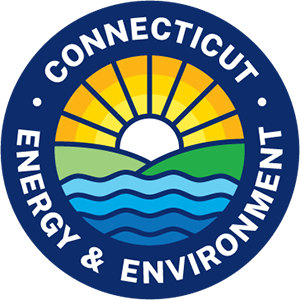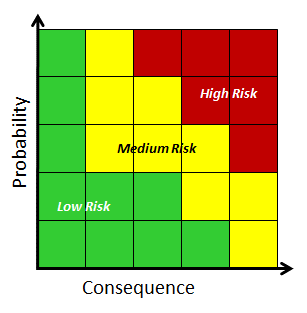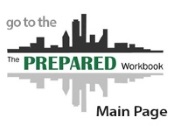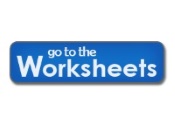Identification of Risk Management Tools
(PREPARED Municipal Workbook)
Voluntary Remediation Programs | Financial Analysis
Risk evaluation balances the likelihood of an adverse event against the consequences of that event. There may be a high likelihood that a risk may be realized, but if the consequences are low, the risk could also be considered low. If there is a high likelihood that a risk may be realized and a high potential consequence, the risk may be considered too high to be acceptable.
Measuring risk. Unacceptable risk is most likely to be found when the probability of an adverse event is high and adverse consequences are also high.
Worksheet #6 provides a list of typical property recovery actions, along with questions related to information pertinent to the action. The original PREPARED Workbook Worksheet #7 has been renumbered to Worksheet #6 presented here.
Risk management is typically conducted in an iterative, staged manner and can involve traditional tools or other approaches, including the following:
- insurance products,
- indemnification agreements,
- additional data gathering,
- delaying acquisition until further cleanup is completed, and
- using a different method of property acquisition.
Resources
- Liability Protection Programs resources
- Funding Sources resources
- See references provided in Community Issues – Funding Sources in Appendix E of the PREPARED Workbook
- See references provided in Managing Project Risk in Appendix E of the PREPARED Workbook
Voluntary Remediation Programs
There are two formal Voluntary Remediation Programs in Connecticut that may be useful in managing potential risks associated with owning or reusing a contaminated property.
Voluntary Remediation under Connecticut General Statutes Section 22a-133x
The Voluntary Remediation Program, as prescribed in Connecticut General Statutes §22a-133x and administered by DEEP’s Remediation Division, is a voluntary program that provides any person a formal means to investigate and remediate a contaminated property. A person enters the 22a-133x Voluntary Remediation Program through the completion and submittal of an environmental condition assessment form (ECAF) to the DEEP. The ECAF is to be prepared under the supervision of a Licensed Environmental Professional (LEP). In most cases, properties entered into voluntary remediation under 22a-133x are overseen by an LEP. However, the DEEP may decide within 30 days of receipt of the ECAF that it will require DEEP's review and written approval of the investigation and remedial action.
For those properties that do not require DEEP’s formal review and approval, the LEP must submit a schedule for investigation and cleanup of the property. Investigation Reports and Remedial Action Plans must be submitted to the DEEP, and public notice must be completed prior to commencement of remedial actions. A final LEP verification, which certifies that the property has been investigated and remediated in accordance with the Connecticut Remediation Standard Regulations (RSRs), must be submitted to the DEEP. For those properties at which DEEP requires formal review and approval, the applicant is required to submit a schedule for the investigation and remediation of the property and all technical plans and reports to the DEEP for review and approval. The DEEP will provide written notice to the applicant at the time the remediation is deemed complete.
Voluntary Remediation under Connecticut General Statutes Section 22a-133y
The Voluntary Remediation Program, as prescribed in Connecticut General Statutes §22a-133y and administered by DEEP’s Remediation Division, is a voluntary program for investigation and cleanup of properties located in areas which have a GB or GC ground water classification and that are not subject to an order, consent order, or stipulated judgment issued by the DEEP.
Under this program, an LEP may conduct environmental investigations, prepare a Remedial Action Plan, oversee remediation, and submit a final Remedial Action Report to the DEEP. The LEP is required to certify that the remedial actions taken on the property to contain, remove, or mitigate the spill are in accordance with the RSRs. This program requires the submission of a remedial action plan to DEEP prior to initiating remedial action and submittal of a remedial action report to the DEEP when remediation is completed. It also requires public notice.
The final Remedial Action Report submitted to the DEEP is deemed approved, unless the DEEP determines within sixty days of submittal that an audit of the remedial action is necessary. The DEEP may also enter into a memorandum of understanding with the property owner which identifies any further remedial action or monitoring activities that are deemed necessary. At the time of transfer of the subject property, a final Remedial Action Report, approved in accordance with section 22a-133y, will be sufficient to support the filing of a Property Transfer Program Form II as defined in section 22a-134.
Financial Analysis
The evaluation of risk management tools will also require an understanding of the finances needed to implement various risk management options and the potential sources of funding. See the brief discussion of a financial analysis, along with the Pro Forma tool and Sources and Uses Chart.
Pro Forma
To properly evaluate risk management options and property recovery actions, the financial risks and benefits of involvement in the reuse project needs to be considered. A general understanding of the financial viability of a desired reuse can help in assessing whether the project goals are realistic and likely to attract private investment. A financial analysis may include estimating the potential costs of undertaking a given property recovery action (e.g., property acquisition costs, environmental investigation costs) and identifying potential sources of revenue and other funding to implement that action and other aspects of the project. Additional discussion on the pro forma can be found in Section 8.2 of the PREPARED Workbook.
To assist in evaluating property recovery actions, an abbreviated pro forma worksheet can be developed using Worksheet #6a. The worksheet is provided in a Microsoft Excel® workbook.
These worksheets are templates and should not be considered static. Municipalities should add to or modify the worksheets as needed to incorporate the information appropriate for the evaluation and document the specific process used.
Sources and Uses Chart
Various funding sources may place limitations on the use of funds; therefore, it is also important to have an understanding of any limitations on the uses of funding from each source. Another tool often utilized for evaluating reuse projects is a sources and uses chart, which provides a mechanism for identifying and balancing potential expenses, funding needs, and sources of funding. The sources and uses chart could be used to evaluate property recovery actions that either involve municipal development projects (e.g., a town building or park) or involve facilitating private development.
The sources and uses chart is essentially a listing of the funding requirements broken down by the type of activity or expenditure required for a reuse project and a listing of the known or potential sources of funding that can be used to off-set an expenditure. Since federal and state funding may have specific limitations as to its use (e.g., site assessment, remedial action) the sources of funding should match the needed expenditure. Private funding may not have these types of limitations; however, in developing the sources and uses chart, it is valuable to match the sources of funds with the planned expenditures to keep track of the funded and non-funded expenditures.
Worksheet #6a can also be used to assist in documenting known or potential sources and uses. The worksheet is provided in a Microsoft Excel® workbook. An example completed sources and use chart is provided in Appendix B of the PREPARED Workbook.
Previous Step: Identify Property Reuse Obstacles and Risks | Next Step: Select Property Recovery Action
Content Last Updated May 12, 2017




